When you hear the name Retin‑A Gel 0.1%, you probably picture a powerful prescription that promises clearer skin and smoother texture. But the market is crowded with other retinoid options, each with its own strengths, drawbacks, and price points. This guide breaks down the science, usage tips, and side‑effect profiles so you can decide whether the gel is right for you or if another alternative fits better.
Key Takeaways
- Retin‑A Gel 0.1% delivers the highest concentration of tretinoin in a gel base, ideal for thick‑skinned areas or severe acne.
- Lower‑strength gels, creams, and other retinoids (tazarotene, adapalene, altreno) offer gentler entry points with fewer irritation issues.
- Choosing the right product depends on skin type, condition severity, tolerance, and budget.
- All retinoids share a common mechanism: they boost cell turnover and stimulate collagen production.
- Proper application, sun protection, and gradual introduction are critical to success.
What is Retin‑A Gel 0.1%?
Retin‑A Gel 0.1% is a prescription‑only topical gel that contains 0.1% tretinoin, the most potent concentration available in a gel formulation. Tretinoin is a synthetic derivative of vitamin A, classified as a retinoic acid. The gel base allows faster absorption compared with creams, making it a go‑to choice for severe acne, pronounced photo‑aging, and stubborn hyperpigmentation.
The gel is packaged in a 30 g tube, typically applied once nightly to clean, dry skin. Because of its strength, doctors often reserve it for patients who have already built tolerance with lower‑strength products.
How Tretinoin Works - The Science Behind the Glow
All retinoids, including tretinoin, work through three core actions:
- Cell turnover acceleration: They bind to retinoic acid receptors (RAR‑α, RAR‑β, RAR‑γ) in the epidermis, prompting keratinocytes to shed older cells more quickly.
- Collagen synthesis boost: Retinoids stimulate fibroblasts to produce new collagen fibers, improving skin firmness and reducing fine lines.
- Melanin dispersion reduction: By normalising melanosome transfer, they help fade existing hyperpigmentation and prevent new dark spots.
These actions are dose‑dependent, which is why 0.1% gel works faster but also irritates more readily than lower‑strength options.
Top Alternatives to Retin‑A Gel 0.1%
Below is a quick snapshot of the most common alternatives, each offering a different balance of potency, tolerability, and cost.
| Product | Active Ingredient & Strength | Formulation | Typical Use Cases | Common Side‑effects | Price (UK, per 30 g) |
|---|---|---|---|---|---|
| Retin‑A Gel 0.1% | Tretinoin 0.1% | Gel | Severe acne, deep wrinkles, melasma | Redness, peeling, itching | £35‑£45 (NHS prescription) |
| Retin‑A Cream 0.025% | Tretinoin 0.025% | Cream | Mild‑to‑moderate acne, early signs of aging | Mild irritation, dryness | £20‑£30 |
| Tazorac (tazarotene) 0.05% Gel | Tazarotene 0.05% | Gel | Psoriasis plaques, acne, post‑inflamed hyperpigmentation | Burning, stinging, scaling | £45‑£55 |
| Differin (adapalene) 0.1% Gel | Adapalene 0.1% | Gel (OTC) | Mild to moderate acne, maintenance after prescription retinoids | Transient dryness, mild redness | £12‑£18 |
| Altreno (tretinoin) 0.05% Cream | Tretinoin 0.05% | Cream | Fine lines, moderate acne, sun‑damaged skin | Peeling, erythema | £30‑£40 |
| Retin‑A Micro 0.04% Gel | Tretinoin 0.04% | Micro‑gel | Patients who need stronger than 0.025% cream but cannot tolerate 0.1% gel | Moderate peeling, sensitivity | £38‑£48 |
| Tretinoin (generic) | Tretinoin 0.025‑0.1% | Various (cream, gel, liquid) | Broad dermatological uses | Varies by concentration | £15‑£50 |
When to Choose Retin‑A Gel 0.1%
If you fall into any of these categories, the 0.1% gel may be the most efficient route:
- Severe inflammatory acne that hasn’t responded to lower‑strength tretinoin or adapalene.
- Deep, established wrinkles (e.g., nasolabial folds) where a higher dose accelerates collagen‑building.
- Persistent melasma that needs a strong, fast‑acting agent.
However, the gel’s potency means you’ll likely experience a “retinoid‑restart” period of redness, peeling, and tightness. If you have sensitive skin, eczema‑prone areas, or are new to retinoids, you might start with Retin‑A Cream 0.025% or an OTC adapalene gel before stepping up.
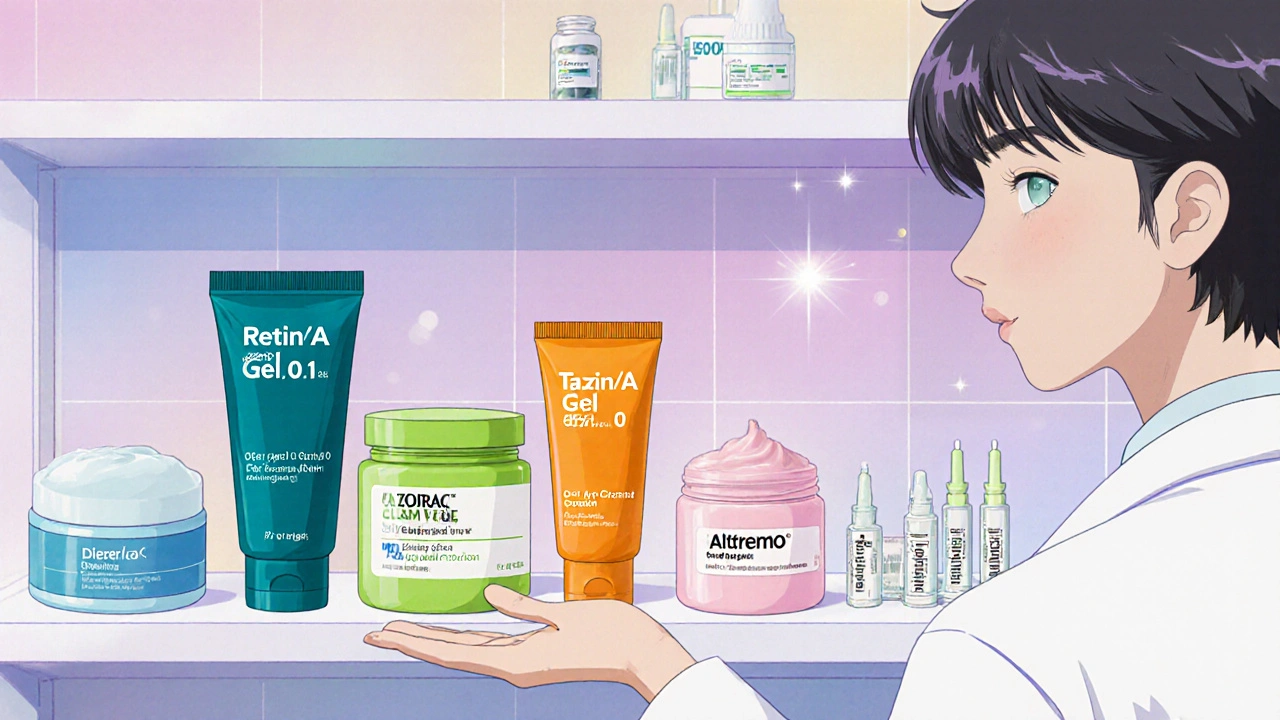
Common Side‑effects & How to Manage Them
All topical retinoids share a core irritation profile. Below are practical steps to keep the skin happy:
- Start slow: Apply a pea‑sized amount every third night for the first two weeks.
- Moisturize immediately: Use a fragrance‑free moisturizer (e.g., ceramide‑rich cream) within 5‑10 minutes of application.
- Sun protection is non‑negotiable: Broad‑spectrum SPF 30+ every morning, even on cloudy days.
- Watch for severe reactions: If you develop blisters, ulceration, or intense burning, stop use and contact a dermatologist.
Most users find that irritation peaks around weeks 3‑4, then subsides as the skin builds tolerance.
How to Use Retin‑A Gel Safely - Step‑by‑Step Guide
- Cleanse with a gentle, pH‑balanced cleanser. Pat dry, leaving skin completely dry (even a few minutes of moisture can dilute the gel’s effect).
- Apply a pea‑sized amount to the target area. Avoid the eye corners, nostril rims, and lips.
- If you’re using other actives (e.g., Vitamin C, AHAs), apply them in the morning and keep retinoid use to nighttime only.
- Follow with a moisturizer as described above. If your skin feels overly tight, you can “sandwich” the retinoid: moisturizer → retinoid → moisturizer.
- Maintain consistency. Skipping nights delays results, but occasional breaks (e.g., during vacations) are fine.
Remember, visible results typically appear after 8‑12 weeks of regular use.
Cost‑Effectiveness and Accessibility
In the UK, Retin‑A Gel 0.1% is generally available via a private prescription, costing around £35‑£45 for a 30 g tube. Many patients qualify for the NHS prescription if the dermatologist deems it medically necessary, which can bring the price down to the standard prescription charge (£9.35 as of 2025). By contrast, OTC adapalene (Differin) costs roughly £12‑£18 but delivers a lower potency. If budget is a concern, discuss with your doctor whether a lower‑strength tretinoin cream can be compounded, which often reduces cost by 30‑40%.
Bottom Line: Match the Product to Your Skin Goals
Retin‑A Gel 0.1% sits at the high‑end of the retinoid spectrum-great for fast, dramatic improvements but also demanding on the barrier. If you need that extra punch for stubborn acne or deep wrinkles, it’s a solid choice. For those just starting out, or with delicate skin, beginning with a milder formulation (Retin‑A Cream 0.025%, Differin 0.1% gel, or even a generic 0.025% tretinoin cream) provides a gentler learning curve.
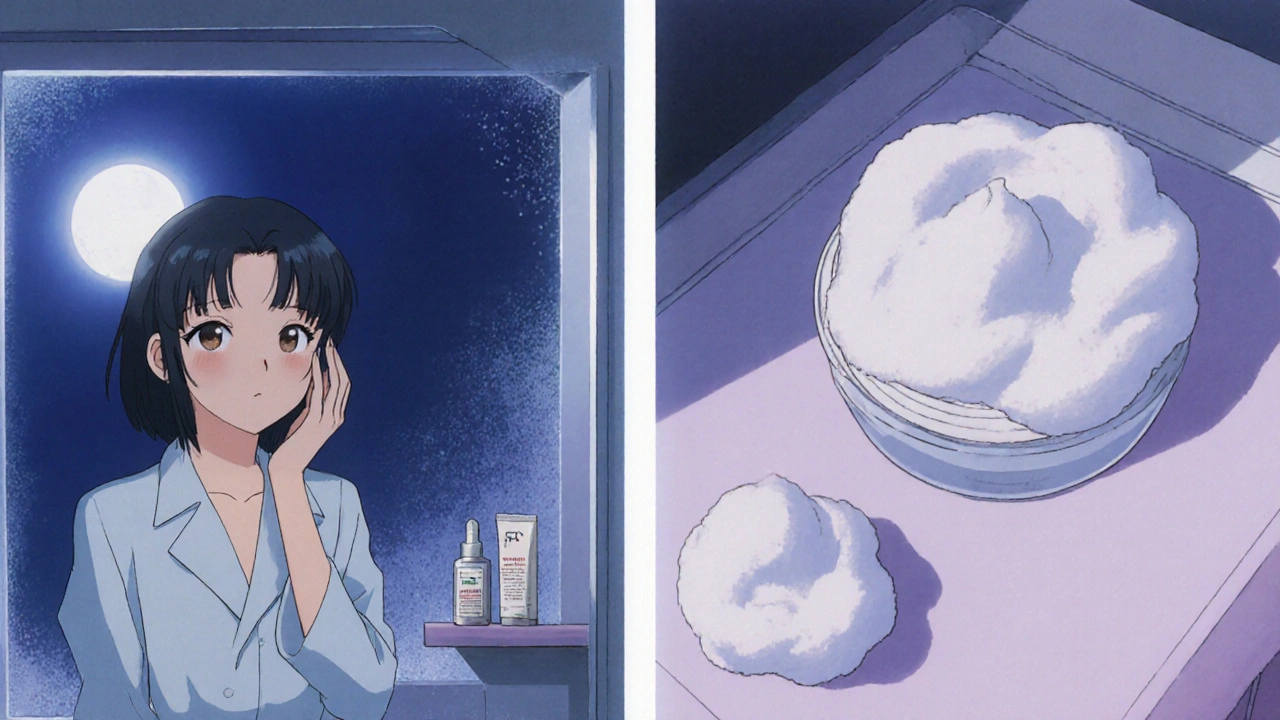
Can I use Retin‑A Gel 0.1% on my face and neck?
Yes, you can treat both areas, but apply a thinner layer on the neck because the skin there is thinner and more prone to irritation. Start with the face first, assess tolerance, then extend to the neck.
How long should I wait before seeing results?
Most users notice smoother texture and a reduction in break‑outs after 4‑6 weeks, but significant improvements in fine lines or hyperpigmentation usually take 8‑12 weeks of consistent nightly use.
Is it safe to use Retin‑A Gel 0.1% during pregnancy?
Tretinoin is classified as Category C. Most dermatologists advise stopping any retinoid therapy before conception and during pregnancy due to limited safety data.
Can I combine Retin‑A Gel with other active ingredients?
Mixing with strong acids (AHAs/BHAs) or Vitamin C can increase irritation. A common approach is to use acids in the morning and the retinoid at night, or to alternate days.
What should I do if I experience severe peeling?
Pause the retinoid for a few days, boost moisturisation with a barrier‑repair cream, and resume at a lower frequency (e.g., every other night). If peeling persists, consult your dermatologist.
Choosing the right retinoid is a personal decision that balances efficacy, skin tolerance, and cost. Use the comparison table, weigh the pros and cons, and don’t hesitate to ask your dermatologist for a tailored plan. With the right approach, you’ll be on the road to clearer, younger‑looking skin.

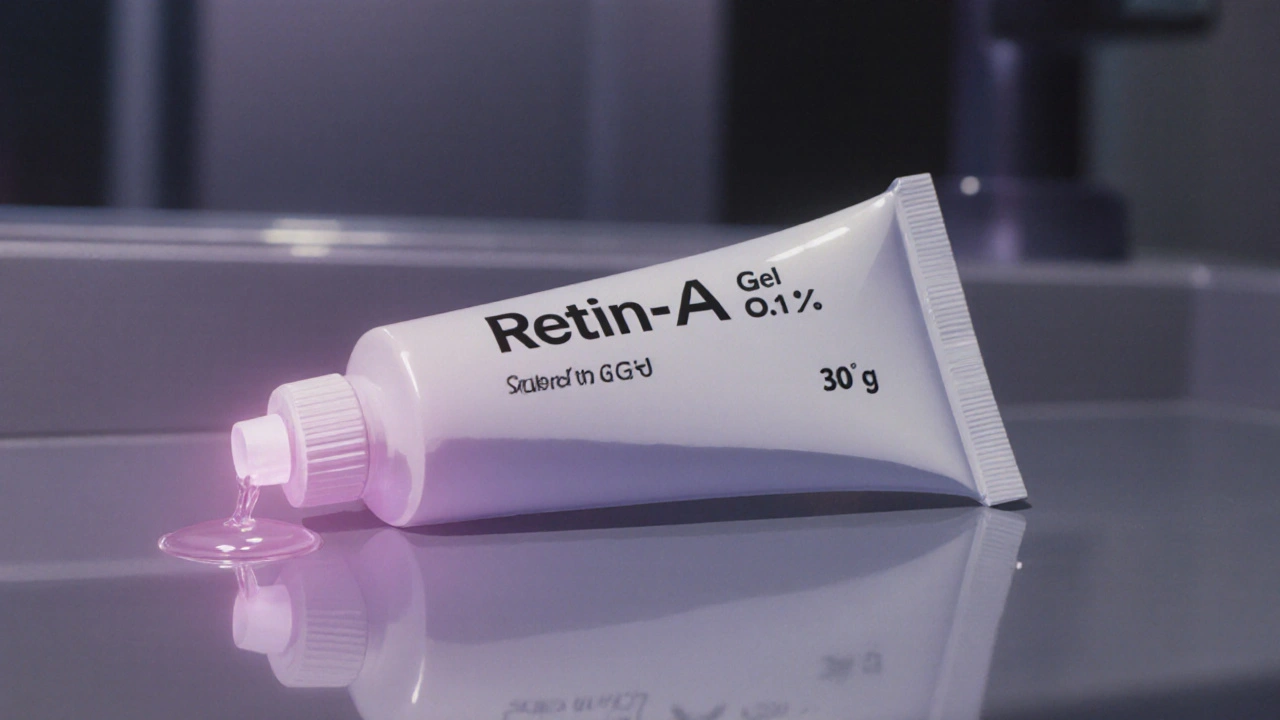
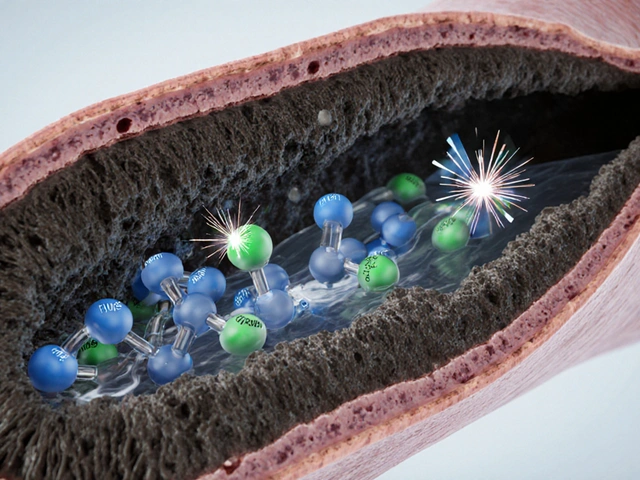
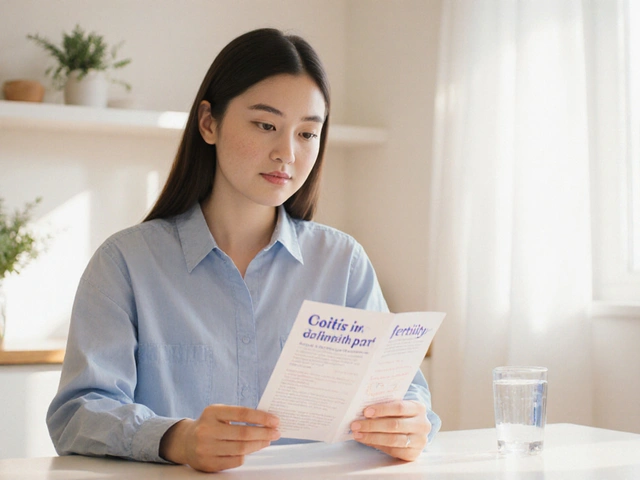
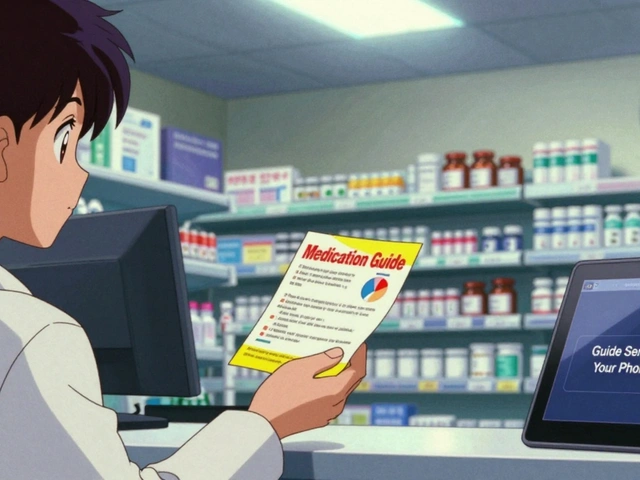


Joe Waldron
October 22, 2025 AT 20:22Retin‑A Gel 0.1% is a powerhouse when it comes to tackling stubborn acne and deep wrinkles, but it’s not a magic wand; you still need a solid routine.
First, always start with a clean, completely dry face-any residual moisture can dilute the gel’s potency.
Apply a pea‑sized amount, spreading it thinly over the target areas, and avoid the delicate corners of the eyes, nostrils, and lips.
Because the concentration is high, expect an initial flare of redness, peeling, or a tightening sensation; this is normal and usually peaks around weeks three to four.
To mitigate irritation, follow the classic “sandwich” method: a light moisturizer, then the retinoid, then another layer of moisturizer within five to ten minutes.
Don’t forget sunscreen-broad‑spectrum SPF 30 or higher is non‑negotiable, even on cloudy days, because retinoids ramp up photosensitivity.
If you’re new to retinoids, consider a tapering schedule: every third night for two weeks, then every other night, before moving to nightly use.
Patients with sensitive skin or a history of eczema should discuss a lower‑strength formulation or a gradual introduction with their dermatologist.
Costs can be a barrier; while private prescriptions run £35‑£45 in the UK, many qualify for NHS coverage, slashing the price to the standard prescription charge.
Generic tretinoin options exist and can be compounded for a fraction of the brand price, though potency may vary slightly.
The gel base allows faster absorption than creams, making it especially effective for thick‑skinned areas like the cheeks or back.
However, the rapid uptake also means a higher risk of barrier disruption, so keep your moisturizer fragrance‑free and ceramide‑rich.
If severe peeling occurs, pause the gel for a few days, boost hydration, and resume at a reduced frequency rather than stopping altogether.
In my experience, consistent use for eight to twelve weeks yields noticeable improvements in texture, hyperpigmentation, and fine lines.
Bottom line: Retin‑A Gel 0.1% delivers results fast, but it demands patience, proper after‑care, and a commitment to sun protection-skip any of those, and you’ll pay the price in irritation.
Wade Grindle
October 24, 2025 AT 00:09The table you posted is spot‑on; it clearly shows that the 0.1% gel packs the most active ingredient per gram, which explains the quicker turnover.
For anyone on a budget, the generic 0.025% cream hits a sweet spot between cost and tolerability.
Just remember that the vehicle matters – creams tend to be gentler, gels are faster‑acting but can sting more.
Joanne Ponnappa
October 25, 2025 AT 03:56Great rundown! 👍
If you’re new to retinoids, start super slow – maybe every 4‑5 days – and watch the mirror. 👀
Don’t forget SPF – it’s the real MVP. 🌞
Sarah Riley
October 26, 2025 AT 06:42From a mechanistic standpoint, the 0.1% gel exhibits a higher receptor occupancy (R↑) profile, precipitating accelerated keratinocyte desquamation and collagen matrix remodeling.
Clinically, this translates to an early onset of irritant dermatitis in susceptible phenotypes.
Sajeev Menon
October 27, 2025 AT 10:29Just a quick tip for newbies: after the first few weeks, if you notice persistent dryness, switch to a richer barrier‑repair cream like cerave moisturising cream – it really helps lock in moisture and reduces the peeling.
Also, try the “every‑other‑night” schedule once your skin calms down; you’ll still get the benefits without the burn.
Emma Parker
October 28, 2025 AT 14:16hey i tried that tip and i loved it!! but i think you forgot 2 thingz – always use a gentle cleanser (no scrubs) and dont over‑apply the gel – pea size is enuf.
also, i put a thin layer of vaseline on my lips before bed – no chapping!
Benedict Posadas
October 29, 2025 AT 18:02Alright folks, if you’re feeling daunted, remember – consistency is king! :)
Start low, stay steady, and celebrate the tiny victories (like that one new smooth spot).
And hey, your skin will thank you with that glow‑up you’ve been dreaming about! ;)
Jai Reed
October 30, 2025 AT 21:49Listen up: if you can’t tolerate any redness, quit the 0.1% gel immediately. This isn’t a luxury product for the faint‑hearted; it’s a potent pharmacologic agent.
Either downgrade to a 0.025% cream or stick with over‑the‑counter adapalene.
Don’t waste money on a formulation you can’t handle.
Tim Blümel
November 1, 2025 AT 01:36Life is a series of trade‑offs; the high‑dose gel offers rapid transformation but demands disciplined after‑care – a reminder that progress often requires discomfort.
Balance, patience, and protection are the three pillars of any successful retinoid journey. 🙏
Michael Vandiver
November 2, 2025 AT 05:22Nice summary! Very helpful👍
Harini Prakash
November 3, 2025 AT 09:09Hey everyone! Just wanted to add that drinking plenty of water and getting enough sleep can actually boost how well your skin responds to retinoids. Keep that skin happy! 😊
Suryadevan Vasu
November 4, 2025 AT 12:56The 0.1% gel’s faster absorption can be advantageous for thick skin, but it also raises the risk of irritation; a gradual dosing schedule mitigates this.
Diane Thurman
November 5, 2025 AT 16:42Ths is bsd asdlfk.